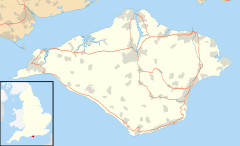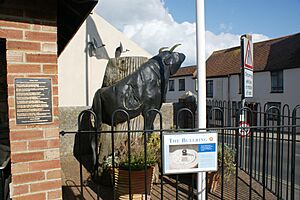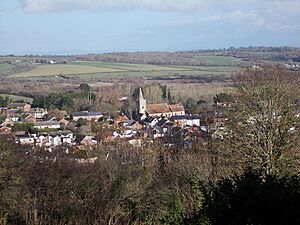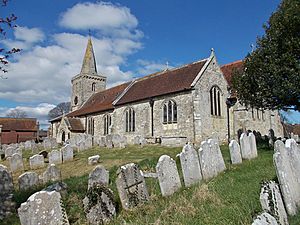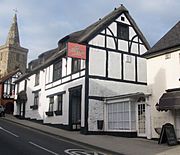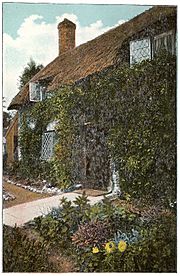Brading facts for kids
Quick facts for kids Brading |
|
|---|---|
 The Bugle Inn, Brading High Street |
|
| Area | 14.2621 km2 (5.5066 sq mi) |
| Population | 1,906 (2021 Census) |
| • Density | 134/km2 (350/sq mi) |
| OS grid reference | SZ607870 |
| Unitary authority | |
| Ceremonial county | |
| Region | |
| Country | England |
| Sovereign state | United Kingdom |
| Post town | SANDOWN |
| Postcode district | PO36 |
| Dialling code | 01983 |
| Police | Hampshire |
| Fire | Isle of Wight |
| Ambulance | Isle of Wight |
| EU Parliament | South East England |
| UK Parliament |
|
Brading is an ancient town on the Isle of Wight. People often call it the 'King's Town'. It is the main town of its civil parish. This parish includes the town itself and nearby areas like Adgestone, Morton, and Nunwell. These areas are located between towns like Ryde, St Helens, and Sandown.
In 2021, about 1,906 people lived in Brading.
Contents
Discover Brading's Ancient Past
Brading's Early History
Brading has been an important port for a very long time. Its old name, 'Brerdynge', likely meant 'people living by the Downs'. This name dates back to at least the year 683.
Roman Life in Brading
A Roman Villa is located just south of the town. Many Roman objects have been found here. This shows that Brading was a busy seaport about 2,000 years ago. Even older signs of human activity have been found on Brading Down.
The Story of St Wilfrid
History tells us that St Wilfrid came to the island in the 680s. He landed at Brading and shared his Christian beliefs with the islanders. This began the conversion of the island to Christianity.
Royal Charters and Town Governance
Brading received its first special document, called a charter, in 1280. King Edward I himself granted this charter. This was unusual because charters were usually given by the island's owner. This is why Brading became known as the 'King's Town'.
Another charter was given by King Edward VI in 1548. This charter allowed the town to hold two fairs each year. Today, the town still has a fair called Brading Day. It takes place on the first weekend of July.
Because Brading is a town, it has a mayor and an elected town council. In the past, Brading even sent two MPs to the Westminster Parliament. Now, it is part of the wider Isle of Wight parliamentary area.
The Old Port of Brading
Until the 1500s, Brading was a very active port. Ships would dock right behind the Bugle Inn on the High Street. They came to Brading Haven for shelter and supplies, especially good quality water.
Over time, the harbour became filled with silt. This made it too shallow for large ships. Many attempts were made to drain the harbour. Sir Hugh Myddelton, who built the New River in London, tried but the sea flooded the land again. Finally, in 1881, a large embankment was built across the harbour. This happened when the railway to Bembridge was built.
Now, Brading is a seaport without any sea! Losing its access to the sea caused Brading to become less important. It did not grow as much as other towns like Cowes and Newport.
Brading's Town Halls
Brading has an old, historic Town Hall near the church. The newer Town Hall was built in 1903. The first Town Hall's exact date is not known. But records from 1729 mention building a new Town Hall, Market House, and Prison.
This new building was restored in 1876. It then housed the Free Town Library. Before the first school opened in 1823, children were taught in the Town Hall. The Town Trust now owns this historic building.
Brading was once the place where weights and measures were checked for all of East Wight. These old standards are still kept in the upper part of the building. The town's charter is also stored there.
The Bull Ring
Outside the new Town Hall, you can see an iron bullring set into the ground. Long ago, this ring was used to hold a bull while dogs baited it. The Governor of the Isle of Wight would even give money to buy the bull. After the event, the meat was given to the poor people of the town.
The Mayor would attend this ceremony in special clothes. A dog, known as the Mayor's Dog, would wear ribbons and be set on the bull. A large wooden carving of a bull now decorates the Bullring. It was made by local artist Paul Sivell.
The Town Gun
Brading owns a special brass gun. It was made in 1549 by the Owine Brothers. The gun was meant to help defend the town from French attacks. However, it was never used in a real battle.
In 1832, the gun was taken to the top of Brading Down. It was fired to celebrate a new law called the Reform Bill. But sadly, it exploded and split apart! This stopped the celebrations for the day.
In the 1950s, the gun was stolen from the "Gunne House" behind St. Mary's Church. It was later found in a sale room far away. It was returned, but not to the town. It went to the Oglander family at Nunwell House. The Town Trust has asked for it back, but the issue is still not settled.
Town Governance Today
Brading is part of an electoral ward called Brading, St. Helens and Bembridge. In 2011, about 6,935 people lived in this ward.
Nature and Beautiful Landscapes
The southwestern part of Brading parish is a protected area. It is part of the Area of Outstanding Natural Beauty. There are also important nature sites near Morton and on the downs.
Brading Down's Views
Brading Down is a great viewpoint and a beautiful downland spot. From the north side, you can look over the town towards the mainland. If you go higher up, you can see the Solent and the Spinnaker Tower in Portsmouth. This high area is also important for finding old historical items.
Brading Marshes Nature Reserve
The RSPB Brading Marshes nature reserve is the first Royal Society for the Protection of Birds reserve on the Isle of Wight. It is located on the land that was once the old harbour. This reserve was bought in 2001. It has lagoons, ditches, reed beds, and meadows. There is also a bit of ancient woodland.
The reserve is free and open to visitors all year. You might see marsh harriers, red squirrels, and cetti's warblers there.
Getting Around Brading
Brading has its own Brading railway station on the Island Line Railway. You can take a train directly to the Wightlink ferry at Ryde Pier Head. The train also stops at Ryde, Sandown, and Shanklin. The southern edge of Brading is also on the island's circular cycle route. This route is used for the yearly "Bicycle Island Randonée" event.
The main A3055 road from Ryde to Sandown goes through the town.
Brading is also well-connected by footpaths and bridleways. The Bembridge Trail goes through the town. There are 71 other paths in the parish. You might often see groups of walkers meeting at the station or the Bullring.
Southern Vectis buses run on route 3 from Brading. These buses go to Newport, Ryde, Sandown, Shanklin, and Ventnor. Night buses also run on weekends.
What to See in Brading
Brading's main street has many useful places. There are four pubs: The Bugle Inn, The Wheatsheaf Inn, The Kynges Well, and the Yarbridge Inn. St. Mary's Church, Brading is at the north end of town. There is also a Methodist chapel.
You can find a small supermarket, a post office, and a newsagent. There are also other shops, a hairdresser's, and a fish and chip shop. Brading Primary School is also in the town.
Brading has many attractions for visitors. These include the Lilliput Doll and Toy Museum. The Roman Villa at Morton is also a popular spot. It has a protective cover and a visitor center.
The Former Brading Waxworks
Another well-known attraction was the Brading Waxworks. This museum and waxworks exhibition was in an old Tudor pub called the "Crown". It first opened in 1965. In 2005, it was renamed 'Brading: The Experience'. A new section called 'World of Wheels' was added, showing vintage vehicles.
However, the attraction closed in late 2009. This was due to fewer visitors and rising costs. It closed for good on January 3, 2010. Most of its large collection was sold off.
Brading Railway Station Museum
The railway station building is still used as a train station. But it has also been restored. It now has a café, a shop with railway items, and a small rail museum. The old signal box has also been restored. Volunteers help to run it.
Sports and Fun
Brading has a Non-League football club called Brading Town F.C.. They play their games at The Peter Henry Ground.
Famous People and Connections
One of Brading's claims to fame is the invention of hymn number boards. These boards are used in churches worldwide. They were invented here by the Rev Legh Richmond. He was a church leader in Brading from 1757 to 1805. He was also a famous writer of inspiring pamphlets.
The Story of Little Jane Squibb
'Little' Jane Squibb was a young Christian girl. She attended Rev Legh Richmond's Sunday school at St Mary's Church. Her story is told in his book, Annals Of The Poor, in a section called 'The Young Cottager'. Jane passed away from Tuberculosis (then called Consumption) on January 30, 1799. Her death greatly affected Rev Legh. You can find her grave in St Mary's Churchyard. Her cottage is in The Mall, Brading.
Brading is also featured in a book. It is the main setting for Maxwell Gray's 1899 novel The House of Hidden Treasure. In the book, Brading is called "Barling".
The Victorian diarist Francis Kilvert visited Brading. He wrote about his visit in his diary.
Notable People from Brading
- Frederick Trumble (1893–1918), a cricketer
See also
 In Spanish: Brading para niños
In Spanish: Brading para niños


